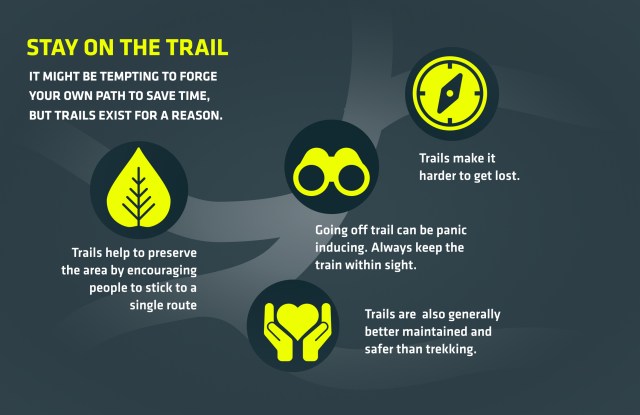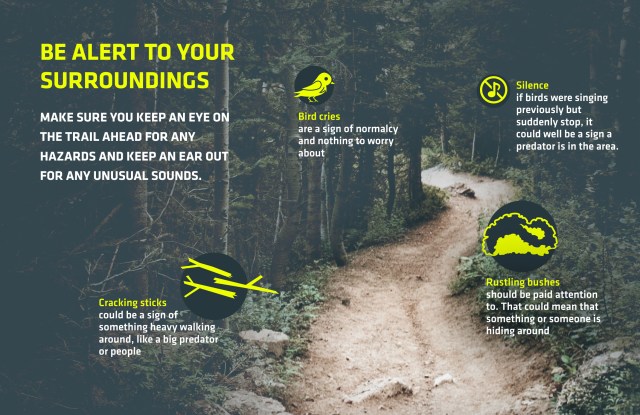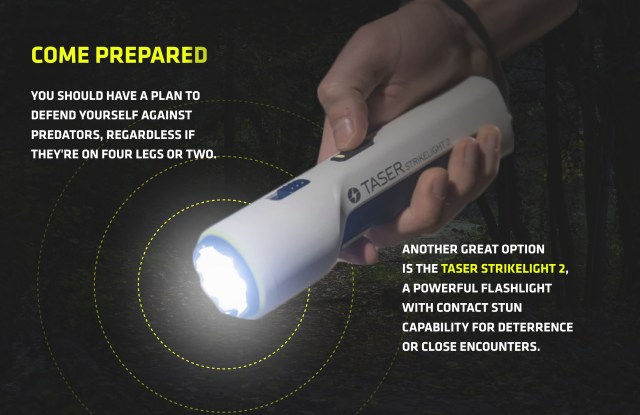Fall makes for an excellent time to go hiking. The temperature becomes nice and cool, the humidity drops, and the trees start turning beautiful shades of red and orange as winter approaches. But no matter how picturesque your surroundings are, there are a few things you should always keep in mind when trekking through the wild. Here’s five tips to keep you safe this fall hiking season.
1. Stay Hydrated

Dehydration is still an issue, even during the colder months. As healthcare studies have shown, it’s more of a threat than in the warmer months because people don’t get as thirsty when it’s cold and, as a result, drink less water.
On top of that, sweat evaporates faster in cold air, and you’ll still end up sweating because your body has to work harder under heavy clothes. Combine this with the gear you’ll already be carrying, and it’s pretty easy to remain oblivious to your dehydration until the symptoms are significant.
2. Stick to The Trail

It might be tempting to forge your own path to save time, but trails exist for a reason. For one, they help to preserve the area by encouraging people to stick to a single route instead of trampling through the underbrush. They’re also generally better maintained and safer than trekking through the brush, not to mention much harder to get lost on.
If you have to go off trail for some reason, such as to set up camp or a bio break, try to keep it within sight. There are few things quite as panic-inducing as going off the path and then realizing you can’t find your way back.
3. Be Alert To Your Surroundings

Situational awareness can help you spot trouble before it spots you. Make sure you keep an eye on the trail ahead for any hazards and keep an ear out for any unusual sounds. Bird cries are nothing to worry about, but things like cracking sticks and rustling bushes should be paid attention to. So is silence; if birds were singing previously but suddenly stop, it could well be a sign a predator is in the area.
4. Know The Area

If it’s not an area you’re already familiar with, make sure you do any necessary background research. Some key points of information to focus on are:
- What’s the terrain like?
- What’s the weather going to be like during your trip?
- What wildlife is active in the area this time of year?
- How long is the trail? Where are its start and end points?
- If you’re doing a multi-day hike, are there predesignated campsites or shelters along the trail? How much ground do you have to cover between each?
5. Come Prepared

Make sure you plan ahead and bring equipment appropriate for the outing. You can get away with the clothes on your back and the things in your pocket for a short trail in the local park. But something more involved, such as the Appalachian Trail and other multi-day hikes, will require more careful planning. A sleeping bag, knife, some form of shelter like a tent or tarp, and enough food and water to last the trip is the bare minimum you’ll need to pack for any multi-day hike.
You should also tell others where you’re going and when you plan to be back, even on shorter hikes. If something happens and you get lost, stranded or worse, these people will be your lifeline. No one else will even know you’ve gone missing or where to start the search before significant time has passed – the first 48 hours of a missing person’s case are the most critical.
Keep your phone with you and charged if you don’t usually wander outside of cell range on your outings. Taking something to recharge it without needing an outlet, like a solar-powered battery bank, is also a good idea if you’re going on multi-day hikes. You’ll find no slim pickings of them online at various price points.
If you do wander outside of cell range often, invest in a Personal Locator Beacon. PLBs are small devices that can send out S.O.S. signals via satellite, allowing rescuers to locate you much more quickly in case you get lost or have an accident.
Even with all these tips, confrontation sometimes becomes unavoidable. You should have a plan to defend yourself against predators, regardless if they’re on four legs or two. Bear spray is a decent deterrent for most things that fall into the former category.For the latter category, you’ll want to consider carrying a TASER device like the TASER Pulse, which weighs just 8 ounces and is easy to slip into a bag or pocket. Another great option is the TASER StrikeLight 2, a powerful flashlight with contact stun capability for deterrence or close encounters.





